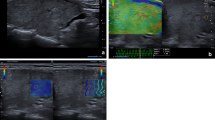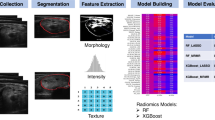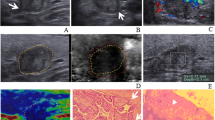Abstract
Purpose
B-mode ultrasound (B-US) and strain elastography ultrasound (SE-US) images have a potential to distinguish thyroid tumor with different lymph node (LN) status. The purpose of our study is to investigate whether the application of multi-modality images including B-US and SE-US can improve the discriminability of thyroid tumor with LN metastasis based on a radiomics approach.
Methods
Ultrasound (US) images including B-US and SE-US images of 75 papillary thyroid carcinoma (PTC) cases were retrospectively collected. A radiomics approach was developed in this study to estimate LNs status of PTC patients. The approach included image segmentation, quantitative feature extraction, feature selection and classification. Three feature sets were extracted from B-US, SE-US, and multi-modality containing B-US and SE-US. They were used to evaluate the contribution of different modalities. A total of 684 radiomics features have been extracted in our study. We used sparse representation coefficient-based feature selection method with 10-bootstrap to reduce the dimension of feature sets. Support vector machine with leave-one-out cross-validation was used to build the model for estimating LN status.
Results
Using features extracted from both B-US and SE-US, the radiomics-based model produced an area under the receiver operating characteristic curve (AUC) \(=\) 0.90, accuracy (ACC) \(=\) 0.85, sensitivity (SENS) \(=\) 0.77 and specificity (SPEC) \(=\) 0.88, which was better than using features extracted from B-US or SE-US separately.
Conclusions
Multi-modality images provided more information in radiomics study. Combining use of B-US and SE-US could improve the LN metastasis estimation accuracy for PTC patients.





Similar content being viewed by others
References
Siegel RL, Miller KD, Jemal A (2017) Cancer statistics, 2017. CA Cancer J Clin 67:7–30
Chen W, Zheng R, Baade PD, Zhang S, Zeng H, Bray F, Jemal A, Qin X, He J (2016) Cancer statistics in China, 2015. CA Cancer J Clin 66:115–132
Briseis AK, Ward MH, Sabra MM, Devesa SS (2011) Thyroid cancer incidence patterns in the United States by histologic type, 1992–2006. Thyroid 21:125–134
Haugen BR, Alexander EK, Bible KC, Doherty GM, Mandel SJ, Nikiforov YE, Pacini F, Randolph GW, Sawka AM, Schlumberger M, Schuff KG, Sherman SI, Sosa JA, Steward DL, Tuttle RM, Wartofsky L (2016) 2015 American Thyroid Association management guidelines for adult patients with thyroid nodules and differentiated thyroid cancer: the American Thyroid Association guidelines task force on thyroid nodules and differentiated thyroid cancer. Thyroid 26:1–133
Liu Z, Wen Z, Liu C, Wang S, Xiong Y, Guo Y, Li X, Sun S, Chen T, Maimaiti Y, Yu P, Huang T (2017) Diagnostic accuracy of ultrasonographic features for lymph node metastasis in papillary thyroid microcarcinoma: a single-center retrospective study. World J Surg Oncol 15:32–36
Luo S, Lim DJ, Kim Y (2012) Objective ultrasound elastography scoring of thyroid nodules using spatiotemporal strain information. Med Phys 39:1182–1189
Shuzhen C (2012) Comparison analysis between conventional ultrasonography and ultrasound elastography of thyroid nodules. Eur J Radiol 81:1806–1811
Zhang Q, Xiao Y, Suo J, Shi J, Yu J, Guo Y, Wang Y, Zheng H (2017) Sonoelastomics for breast tumor classification: a radiomics approach with clustering-based feature selection on sonoelastography. Ultrasound Med Biol 43:1058–1069
Aerts HJ, Velazquez ER, Leijenaar RT, Parmar C, Grossmann P, Carvalho S, Bussink J, Monshouwer R, Haibe-Kains B, Rietveld D, Hoebers F, Rietbergen MM, Leemans R, Dekker A, Quackenbush J, Gillies RJ, Lambin P (2014) Decoding tumour phenotype by noninvasive imaging using a quantitative radiomics approach. Nat Commun 5:4006–4015
Gillies RJ, Kinahan PE, Hricak H (2015) Radiomics: images are more than pictures, they are data. Radiology 278:563–577
Huang Y, Liang C, He L, Tian J, Liang C, Chen X, Ma Z, Liu Z (2016) Development and validation of a radiomics nomogram for preoperative prediction of lymph node metastasis in colorectal cancer. J Clin Oncol 34:2157–2164
Bogowicz M, Riesterer O, Stark LS, Studer G, Unkelbach J, Guckenberger M, Tanadini-Lang S (2017) Comparison of PET and CT radiomics for prediction of local tumor control in head and neck squamous cell carcinoma. Acta Oncol 56:1531–1536
Wu G, Chen Y, Wang Y, Yu J, Lv X, Ju X, Shi Z, Chen L, Chen Z (2018) Sparse representation-based radiomics for the diagnosis of brain tumors. IEEE Trans Med Imaging 99:1–13
Wan T, Cui B, Wang Y, Qin Z, Lu J (2017) A radiomics approach for automated identification of aggressive tumors on combined PET and Multi-parametric MRI. In: International conference on neural information processing. Springer, Cham, pp 731–739
Wu S, Zheng J, Li Y, Yu H, Shi S, Xie W, Liu H, Su Y, Huang J, Lin T (2017) A radiomics nomogram for the preoperative prediction of lymph node metastasis in bladder cancer. Clin Cancer Res Off J Am Assoc Cancer Res 23:6904–6911
Yu J, Shi Z, Lian Y, Li Z, Liu T, Gao Y, Wang Y, Chen L, Mao Y (2016) Noninvasive IDH1 mutation estimation based on a quantitative radiomics approach for grade II glioma. Eur Radiol 27:3509–3522
Su X (2010) Micro calcification clusters detection algorithms based on SVM in mammograms. Dissertation, Lanzhou University
Li Y, Namburi P, Yu Z, Guan C, Feng J, Gu Z (2009) Voxel selection in fMRI data analysis based on sparse representation. IEEE Trans Biomed Eng 56:2439–2451
Wang S, Wei J (2017) Feature selection based on measurement of ability to classify subproblems. Neurocomputing 224:155–165
Zhang C, Shao X, Li D (2013) Knowledge-based support vector classification based on C-SVC. Procedia Comput Sci 17:1083–1090
Saito T, Rehmsmeier M (2015) The precision-recall plot is more informative than the ROC plot when evaluating binary classifiers on imbalanced datasets. PLoS ONE 10(3):e0118432
Delong ER, Delong DM, Clarke-Pearson DL (1988) Comparing the areas under two or more correlated receiver operating characteristic curves: a nonparametric approach. Biometrics 44(3):837–45
Gu J, Pitz M, Breitner S, Birmili W, Klot SV, Schneider A, Soentgen J, Reller A, Peters A, Cyrys J (2012) Selection of key ambient particulate variables for epidemiological studies—applying cluster and heatmap analyses as tools for data reduction. Sci Total Environ 435:541–550
Kim S-Y, Kwak JY, Kim EK, Yoon JH, Moon HJ (2015) Association of preoperative US features and recurrence in patients with classic papillary thyroid carcinoma. Radiology 277:574–583
Nam SY, Shin JH, Han BK, Ko EY, Ko ES, Hahn SY, Chung JH (2013) Preoperative ultrasonographic features of papillary thyroid carcinoma estimate biological behavior. J Clin Endocrinol Metab 98:1476–1482
Kwak JY, Kim E-K, Kim MJ, Son EJ, Chung WY, Park CS, Nam KH (2009) Papillary microcarcinoma of the thyroid: estimateing factors of lateral neck node metastasis. Ann Surg Oncol 16:1348–1355
Bojunga J, Herrmann E, Meyer G, Weber S, Zeuzem S, Fried- rich-Rust M (2010) Real-time elastography for the differentiation of benign and malignant thyroid nodules: a meta-analysis. Thyroid 20:1145–50
Moon HJ, Kim E-K, Yoon JH, Kwak JY (2012) Differences in the diagnostic performances of staging US for thyroid malignancy according to experience. Ultrasound Med Biol 38:568–573
Zhou H, Deng Z, Xia Y, Fu M (2016) A new sampling method in particle filter based on Pearson correlation coefficient. Neurocomputing 216:208–215
Wu Q, Li Y, Wang Y, Hu B (2015) Sonographic features of primary tumor as independent predictive factors for lymph node metastasis in papillary thyroid carcinoma. Clin Transl Oncol 17:830–834
Ebeed AE, Romeih EH, Refat MM, Salah NM (2017) Role of ultrasound, color Doppler, elastography and micropure imaging in differentiation between benign and malignant thyroid nodules. Egypt J Radiol Nucl Med 48:603–610
Zhang FJ, Han RL (2013) The value of acoustic radiation force impulse (ARFI) in the differential diagnosis of thyroid nodules. Eur J Radiol 82:686–690
Freudenthal B, Williams GR (2016) Thyroid stimulating hormone suppression in the long-term follow-up of differentiated thyroid cancer. Clin Oncol 29:325–328
Acknowledgements
This study was funded by the National Natural Science Foundation of China (61471125)
Author information
Authors and Affiliations
Corresponding authors
Ethics declarations
Conflict of interest
We have no conflict of interest to declare.
Ethical approval
All procedures performed in studies involving human participants were in accordance with the ethical standards of the institutional and/or national research committee and with the 1964 Helsinki declaration and its later amendments or comparable ethical standards. For retrospective study, formal consent is not required. Informed consent was obtained from all individual participants included in the study. This study has been approved by the ethics committee of the Peking University Third Hospital.
Rights and permissions
About this article
Cite this article
Liu, T., Ge, X., Yu, J. et al. Comparison of the application of B-mode and strain elastography ultrasound in the estimation of lymph node metastasis of papillary thyroid carcinoma based on a radiomics approach. Int J CARS 13, 1617–1627 (2018). https://doi.org/10.1007/s11548-018-1796-5
Received:
Accepted:
Published:
Issue Date:
DOI: https://doi.org/10.1007/s11548-018-1796-5




